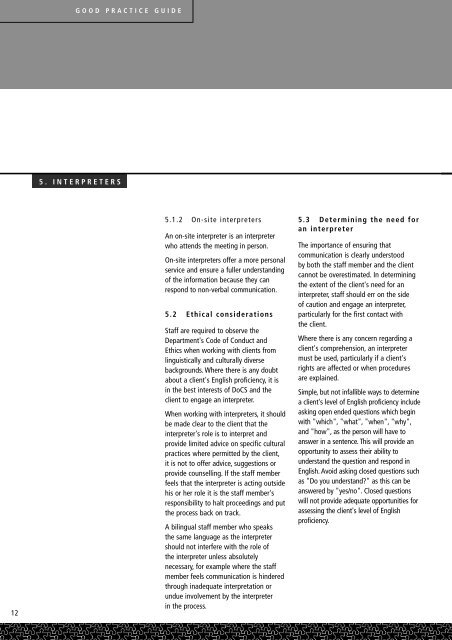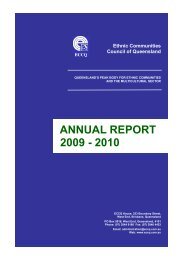Good Practice Guide
CALD Good practice guide
CALD Good practice guide
You also want an ePaper? Increase the reach of your titles
YUMPU automatically turns print PDFs into web optimized ePapers that Google loves.
GOOD PRACTICE GUIDE<br />
5. INTERPRETERS<br />
12<br />
5.1.2 On-site interpreters<br />
An on-site interpreter is an interpreter<br />
who attends the meeting in person.<br />
On-site interpreters offer a more personal<br />
service and ensure a fuller understanding<br />
of the information because they can<br />
respond to non-verbal communication.<br />
5.2 Ethical considerations<br />
Staff are required to observe the<br />
Department's Code of Conduct and<br />
Ethics when working with clients from<br />
linguistically and culturally diverse<br />
backgrounds. Where there is any doubt<br />
about a client's English proficiency, it is<br />
in the best interests of DoCS and the<br />
client to engage an interpreter.<br />
When working with interpreters, it should<br />
be made clear to the client that the<br />
interpreter's role is to interpret and<br />
provide limited advice on specific cultural<br />
practices where permitted by the client,<br />
it is not to offer advice, suggestions or<br />
provide counselling. If the staff member<br />
feels that the interpreter is acting outside<br />
his or her role it is the staff member's<br />
responsibility to halt proceedings and put<br />
the process back on track.<br />
A bilingual staff member who speaks<br />
the same language as the interpreter<br />
should not interfere with the role of<br />
the interpreter unless absolutely<br />
necessary, for example where the staff<br />
member feels communication is hindered<br />
through inadequate interpretation or<br />
undue involvement by the interpreter<br />
in the process.<br />
5.3 Determining the need for<br />
an interpreter<br />
The importance of ensuring that<br />
communication is clearly understood<br />
by both the staff member and the client<br />
cannot be overestimated. In determining<br />
the extent of the client's need for an<br />
interpreter, staff should err on the side<br />
of caution and engage an interpreter,<br />
particularly for the first contact with<br />
the client.<br />
Where there is any concern regarding a<br />
client's comprehension, an interpreter<br />
must be used, particularly if a client's<br />
rights are affected or when procedures<br />
are explained.<br />
Simple, but not infallible ways to determine<br />
a client's level of English proficiency include<br />
asking open ended questions which begin<br />
with "which", "what", "when", "why",<br />
and "how", as the person will have to<br />
answer in a sentence. This will provide an<br />
opportunity to assess their ability to<br />
understand the question and respond in<br />
English. Avoid asking closed questions such<br />
as "Do you understand?" as this can be<br />
answered by "yes/no". Closed questions<br />
will not provide adequate opportunities for<br />
assessing the client's level of English<br />
proficiency.
















